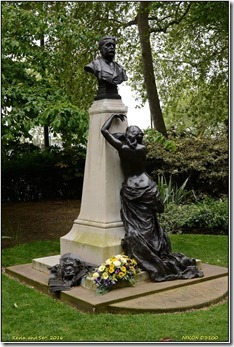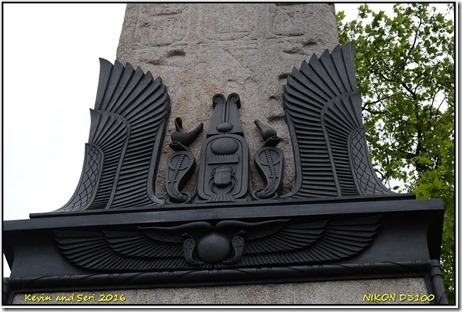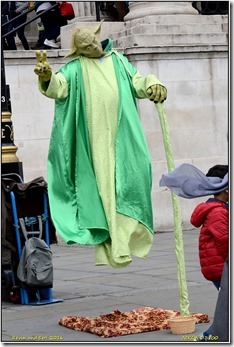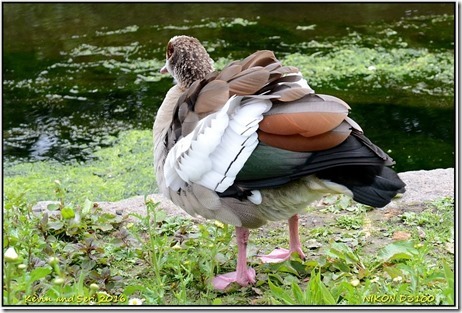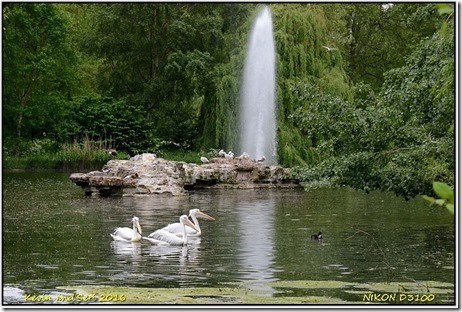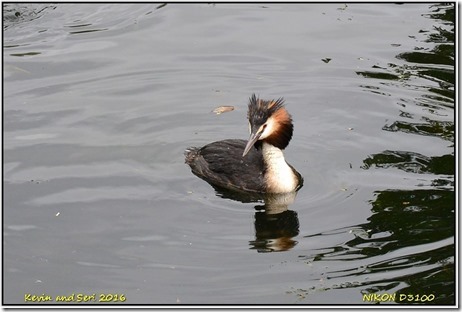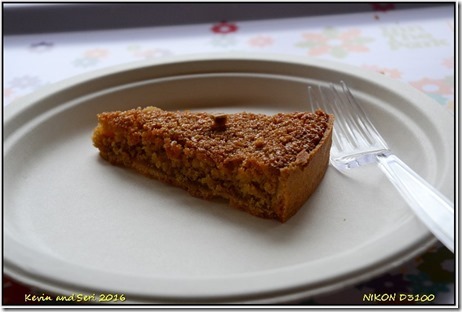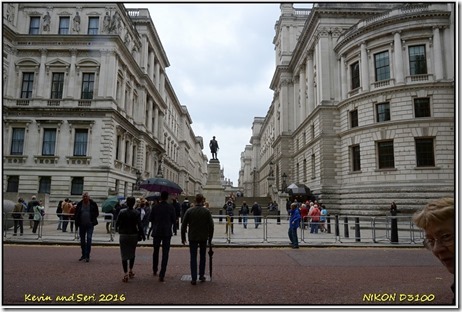Last year, HR and I had been planning a trip to London. But due to unforeseen circumstances, I could not make it. So this year, we planned it well in advance but due to our very busy schedules we finally made it. We left Coventry on the day when the English Defence League, a right-wing group, was marching through city-centre. The train station was full of policemen and police dogs to welcome them.
We were on the 9 am slow Cross Country train and got off at Rugby where we boarded a faster train to London. The countryside was lush with a touch of yellow as fields and fields of rapeseed just coming into bloom. Luminous beech hedges thread the upland fields and marked the onset of spring into summer with drapes of fresh leaves and sturdy trunks were topped with diaphanous crowns. Sheep with April-born lambs scattered across the airy pastures while cows and calves lie about in the warmth. It was very tranquil before we arrived at our destination.
We took the tube and changed once before we arrived at the Victoria Embankment Gardens. This vibrant public park was part of the chain of open spaces along Victoria Embankment, designed by Sir Joseph Bazelgette and opened in 1865. There were grass areas with impressive bedding displays and spectacular statutes and memorials. We stopped to read the plaques with amazing attributes and achievements. These included that of John Stuart Mill, a listed grade II stone fountain erected in 1879 as a memorial to the temperance worker Lady Henry Somerset statue of girl with begging bowl, William Howard Forster, and even a memorial to Robert Burns. It was lovely to get off the pavement to cool down with a stroll through the gardens.
We then stopped at these impressive gates and wondered what they were. It was quite a challenge to get close as shrubbery screened it from view. It was the grade 1 listed York Water Gate, a Thameside watergate which was built in the 1200s for the Bishop of Norwich and was subsequently granted to George Villiers, Duke of Buckinghamshire (assassinated 1628). Made of Portland Stone, it was a tripartite monumental gateway in a bold Franco-Flemish Baroque style, similar in design to the Fontaine de Medicis.
At the end of the path we walked out of the entrance with a view of the north bank of Thames and Waterloo Bridge. The Embankment was laid out in the style of a Parisian Quay with a wide avenue of planes, landing places and piers built into the riverside, and broad pavements either side of the roadway. The sun came out and we enjoyed the buzz of enjoying the sights across the water. There were plenty of cruise boats taking visitors up and down the river.
We stopped at Cleopatra’s Needle, an original Egyptian obelisk, which was teeming with tourists. It was made in Egypt for the Pharoah Thotmes III in 1460 BC, making it almost 3,500 years old. It was known as Cleopatra’s Needle as it was brought to London from Alexandria, the royal city of Cleopatra. It was brought in 1878, after a horrendous journey by sea on a specially designed cigar-shaped container ship also called the Cleopatra, because Britain wanted something big and noticeable to commemorate Nelson’s victory at the Battle of the Nile in 1798. The public subscribed £15K for it.
The 60 foot, 180-ton red granite was originally one of a pair erected in Heliopolis for the Pharoah and taken to Alexandria by Emperor Augustus 15 years after Cleopatra’s death. It was presented to Britain in 1819 by the Turkish viceroy of Egypt and took 60 years before it made its way to London. The 2nd obelisk was in New York’s Central Park, close to the Metropolitan Museum.
Two large bronze Sphinxes laid on either side of the Needle which were facing the wrong way because Queen Victoria preferred it that way!!! . These were Victorian versions of the traditional Egyptian original. The benches on the Embankment had winged sphinxes on either side as their supports. There were 4 plaques mounted around the base of the Obelisk giving a brief history of the ‘Needle’ and its journey to London. One of the sphinx was damaged by a bomb dropped during the Zeppelin raid on London in 1917.
The carvings were amazing and still visible. Unfortunately, the hieroglyphs were quite eroded. It was a shame that it was not preserved in a much controlled environment as it was older than London itself. This monument had stood the test of time; thousands of years old, between empires and 2 world wars. This was the closest thing to ancient Egypt I ‘d encountered and I’m chuffed to bits.
From here, we took a leisurely stroll westwards through Northumberland Avenue to get to the National Gallery. When built, the street was designed for luxury accommodation, including the seven-storey Grand Hotel, the Victoria and the Metropole. Except for the Grand Hotel, the rest of the hotels were taken over by the War Office. The street had been commemorated in the Sherlock Holmes novels including The Hound of the Baskervilles, and was a square on the British monopoly board. The Northumberland Arms public house was renamed the Sherlock Holmes in 1957, and contained Holmes-related exhibits from the 1951 Festival of London.
At the end of the road was the buzzing Trafalgar Square full of visitors, tourists and spectators. It was an amazing and vibrant place to be, to look, to stare and be stared. It was a photographer’s dream. Unfortunately, on that day, there were barricades all over the place because the Square was going to be turned into an open air BBC concert the next day. Aargh… but there were still plenty of interesting bits to point the camera at as the Square was surrounded by museums, galleries, cultural spaces and historic buildings.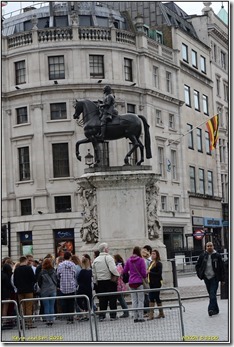
Trafalgar Square was a public space named after the Battle of Trafalgar as suggested by architect George Ledwell Taylor, commemorating Admiral Horatio Nelson’s victory over the French and Spanish in 1805 during the Napoleonic Wars. Plinths were provided for sculpture and pedestals for lighting and all the stonework was of Aberdeen granite.
The main monument was Nelson’s Column built between 1840 and 1843 to a design by William Ralton. It was a column of the Corinthian order built from Dartmoor granite. The Craigleith sandstone statute was by E. H. Bally and the 4 bronze Barbary lions on the base, added in 1867, were designed by Sir Edwin Landseer. The base contained friezes depicting the Admiral’s famous naval battles and was cast from the bronze of a captured cannon.
There were 4 plinths around the edge of the Trafalgar Square. The first was a statute of King George IV on horseback, the 2nd was Sir Henry Havelock and the 3rd was Sir Charles Napier. The north-west plinth was one of the most talked-about photographed public spaces in the country. Having laid empty and unused for a century and a half, it was now used to house a series of modern art pieces. The latest, the 10th giant sculpture, was the bronze Gift Horse by the German artist Hans Haacke. It was a skeletal riderless house inspired by the equestrian statute of William IV that was originally planned for the spot and based on an engraving by George Stubbs, the English painter whose famous painting of the racehorse Whistlejacket could be seen in the nearby National Gallery. It was a beautiful sculpture against the London skyline.
The fountains were built in 1845, and redesigned by Edward Lutyens in 1939. They were installed to counteract the effects of reflected heat and glare from the asphalt surface. They were little-known memorials to 2 naval commanders, Admiral Earl David Beatty and Earl John Jellicoe. The mermaids, dolphins and tritons were installed later.
The place was packed and buzzing. People were milling about, as if they were waiting for something to happen. There were a few street performers all dressed as Star War characters and acted as ‘standing statutes. There was even 3 Yodas in different locations who appeared to hover while sitting on their platforms. In London, all living statutes on the South bank and Convent Garden were licensed and had public-liability insurance. Unfortunately, the Square was public land and remained a-free-for-all.
Then we entered the very grand National Gallery which housed more than 2,300 works and was one of the greatest assemblies of Western European art in the world. Founded in 1824, the nucleus of the holdings was not a royal collection, as in the Louvre or the Prado, but the British government acquisition of 38 paintings from the estate of John Julius Angerstein. Now there were paintings dating from the 13th to the 20th century on all genres, styles and movements, from the medieval masters to the French impressionists.
We were here to see the “Dutch Flowers” exhibition in Room 1. But first, we need food to recharge our batteries. We’d lunch at the uber cafe in the east Wing with its opulent ambience and high ceilings. The red leather booths were very British too and reproductions of some of the Gallery’s prime exhibits were on the walls. The National Cafe was one of several Peyton & Byrne establishments in London. Since it was lunch time, it was very busy but fortunately, we managed to secure a table. I’d the courgette and goat’s cheese tart with root vegetable slaw and it was scrumptious.
We’d a quick browse at the souvenir shop and I bought a tin of vanilla fudge for Babe. Then we slowly made our way to the exhibition. The exhibition explored Dutch flower paintings from its beginning in the early 17th century to its peak in the late 18thcentury, and was the first display of its kind in 20 years. ‘Dutch Flowers’ presented an overview of the leading artists in the field, such as Ambrosius Bosschaert the Elder, Jan van Huysum, and Rachel Ruysch. It provided a chance to admire their stylistic and technical characteristics and the exquisite details of their paintings.
Featuring works from the collection alongside long-term loans, the exhibition drew connections between the development of flower painting in the Netherlands to increased interest in botany, horticulture, and the phenomenon of ‘tulip mania’ in the Dutch Golden Age. Unfortunately, it was housed in a very small room that was bursting with visitors making it impossible to appreciate the beauty of the collection.
After about an hour, we went to check the impressionist paintings on Level 2. The area was divided into 66 different rooms containing paintings from the 13th to the early 20th century paintings. It was just impossible to check out all the paintings so we went into rooms that weren’t crowded which was quite a feat. We managed to see Degas, Van Gogh, Cezanne, Manet, Monet and off course Room 34 with paintings by Turner, Gainsborough and Constable. We were here for nearly 2 hours jostling for space to immerse in culture and wonderment. We could had stayed longer but we’d a garden to visit and a train to catch. We made plans to come again and check the rest of the rooms.
From the National Gallery, we walked through the world famous landmark, the Admirality Arch with its impressive archways that formed the ceremonial entrance to the Mall leading up to Buckingham Palace. Traffic don’t pass through the massive central arch which was only opened for state occasions. The Arch was commissioned by King Edward VII to commemorate his mother’s, Queen Victoria, death.
Made of Portland Stone, the majestic Grade 1 listed curved building was designed by Sir Aston Webb and was completed in 1911, shortly after King Edward VII had passed away. A Latin inscription on the attic of the arch paid tribute to the Queen. "ANNO DECIMO EDWARDI SEPTIMI REGIS VICTORIÆ REGINÆ CIVES GRATISSIMI MDCCCCX" which can be translated as “In the tenth year of the reign of King Edward VII, to Queen Victoria from a grateful nation, 1910”.
As I stood upon London Bridge and viewed the mighty throng
Of thousands of people in cabs and 'busses rapidly whirling along,
All furiously driving to and fro,
Up one street and down another as quick as they could go:
Then I was struck with the discordant sound of human voices there,
Which seemed to me like wild geese cackling in the air:
And the river Thames is a most beautiful sight,
To see the steamers sailing upon it by day and by night.
And the Tower of London is most gloomy to behold,
And the crown of England lies there, begemmed with precious stones and gold;
King Henry the Sixth was murdered there by the Duke of Glo'ster,
And when he killed him with his sword he called him an impostor.
St. Paul's Cathedral is the finest building that ever I did see;
There's nothing can surpass it in the city of Dundee,
Because it's most magnificent to behold
With its beautiful dome and spire glittering like gold.
And as for Nelson's Monument that stands in Trafalgar Square,
It is a most stately monument I most solemnly declare,
And towering defiantly very high,
Which arrests strangers' attention while passing by.
Then there's two beautiful water-fountains spouting up very high,
Where the weary travellers can drink when he feels dry;
And at the foot of the monument there's three bronze lions in grand array,
Enough to make the stranger's heart throb with dismay.
Then there's Mr Spurgeon, a great preacher, which no one dare gainsay
I went to hear him preach on the Sabbath-day.
And he made my heart feel light and gay
When I heard him preach and pray.
And the Tabernacle was crowded from ceiling to floor,
And many were standing outside the door;
He is an eloquent preacher, I solemnly declare,
And I was struck with admiration as I on him did stare.
Then there's Petticoat Lane I venture to say,
It's a wonderful place on the Sabbath day;
There wearing apparel can be bought to suit the young or old
For the ready cash - silver, coppers, or gold.
Oh! mighty city of London! you are wonderful to see,
And thy beauties no doubt fill the tourist's heart with glee;
But during my short stay, and while wandering there,
Mr Spurgeon was the only man I heard speaking proper English I do declare.
~William Topaz McGonagall ‘Descriptive Jottings of London’~
After rattling hundreds of shots, we finally made our way to St. James Park, the oldest of London’s 8 Royal Parks. There was quite a lot of work going on because the Park was getting ready for the Trooping the Colour which was held on Horse Guards Parade to mark the Queen’s official birthday in June. It was a lovely afternoon, the Park was buzzing with families having picnics, strolling along or just sunbathing and relaxing on the deck chairs watching the world go by. Lawns, flower beds, trees and shrubs surrounded an elongated lakes with two islands. It was an oasis in the middle of a hectic city.
But for me, all I wanted to see was the pelicans but they were AWOL!!! Aargh…but thankfully the wildlife especially the waterfowl made it up. One of the key habitats was the lake, home to them with nesting sites on Duck Island and West island. According to the website there were 15 different species and I spotted the Mallards, Tufted ducks, Shelducks, Galdwall, Teals, Pintails, Shovelers, Common Pochards, Red Crested Pochards, Ruddy Shelducks, Canada Geese, Greylags, Mute swans, Moorhens, Coots, Little grebes, Great Crested Grebes, Egyptian geese, Snow goose, Bar headed goose, Herons and Smew. It was crazy to see them so close in the middle of a bustling city.
Near West Island, I was delighted to see at least 3 families of Egyptian goose with their adorable goslings of different stages of growth. Related to the Shelduck and a native of sub-tropical Africa, these pale brown and grey goose had distinctive dark brown eye-patches that made them look as if wearing spectacles and contrasting white wing patches in flight. It was introduced as an ornamental wildfowl species in the late 17th century and had escaped into the wild, and successfully breeding in a feral state.
When I got too close, Mum gave out a raucous quack that always sounded in aggression and incessantly at the slightest disturbance when tending her young. It was lovely to see her escorting her flotillas of goslings to the water. The downy goslings were similar in markings to those of a Shelduck. Both male and female care for their offspring until they were old enough to care for themselves.
We were near the a new water feature, The Tiffany Fountain, when I spotted the piece de resistant, the world famous pelicans gliding serenely in the lake. Whoop…whoop. But first about the fountain. Taking centre stage at the lake, this stunning 20 feet water plume leapt against the magnificent backdrop of Buckingham Palace, Whitehall and Horse Guards Parade. The Fountain recreated an historical fountain that was first installed in 1966.
Pelicans had been living in St. James Park for over 350 years. They were first introduced in 1664, as a gift to King Charles II from the Russian ambassador. They were described by John Evelyn in February 1665, a contemporary of Samuel Peyps as ‘fowle between a stork and a swan’. Since then, over 40 pelicans had made London their home. These were Eastern (or Great) White Pelicans.
In the wild, these bag-jawed birds lived in colonies and were gregarious animals who fished and roost together. Their natural habitat was large shallow water so St James Park lake provided an ideal environment. They were friendly creatures and was often seen climbing out of the lake to sit on benches alongside visitors. But not today which was a shame. I was also gutted that I’d missed their feeding time which was between 2.30 and 3 pm.
“A remarkable bird is the pelican
It’s mouth can hold more than its belican”
~Dixon Lanier Merritt~
We were very surprised to see this heron flying in and landing right in front of us. Then it strutted confidently about 5 metres to where we were standing giving us the eye like what are you doing here. Another flew in and started chasing off its competitor away. There was a mighty loud croaking ‘fraaaank’ before they flew off into the island.
We also checked out this cute-as-a- button building at the edge of the lake. It was named aptly Duck Cottage and was built by the ornithological Society of London in 1837. The cottage was Grade II listed, while the rest of the island it sat on was home to the water treatment facilities and pump for the fountain. Outside the cottage was a small vegetable garden full of leeks, beetroots, onions, carrots and potatoes.
The bird of gardens sang unto the rose,
New blown in the clear dawn: "Bow down thy head!
As fair as thou within this garden close,
Many have bloomed and died." She laughed and said
"That I am born to fade grieves not my heart
But never was it a true lover's part
To vex with bitter words his love's repose."
The tavern step shall be thy hostelry,
For Love's diviner breath comes but to those
That suppliant on the dusty threshold lie.
And thou, if thou would’st drink the wine that flows
From Life's bejewelled goblet, ruby red,
Upon thine eyelashes thine eyes shall thread
A thousand tears for this temerity.
Last night when Irem's magic garden slept,
Stirring the hyacinth's purple tresses curled,
The wind of morning through the alleys stept.
"Where is thy cup, the mirror of the world?
Ah, where is Love, thou Throne of Djem?" I cried.
The breezes knew not; but "Alas," they sighed,
"That happiness should sleep so long!" and wept.
Not on the lips of men Love's secret lies,
Remote and unrevealed his dwelling-place.
Oh Saki, come! the idle laughter dies
When thou the feast with heavenly wine dost grace.
Patience and wisdom, Hafiz, in a sea
Of thine own tears are drowned; thy misery
They could not still nor hide from curious eyes.
~Hafiz ‘The Bird of Gardens’
After about 2 hours in the park, we headed to the bustling Inn the Park for coffee. It was a lovely place to unwind for a relaxed drink overlooking the lake. I wanted a traditional cream tea but it had already sold out. I had to settle for the famous Bakewell tart, a short crust pastry with a layer of jam and covered with a sponge filling enriched with ground almonds. This was washed down with a steaming cup of English garden mint tea. What a lovely way to wind down before we made our way home.
We walked past the Horse Guards Parade and followed a group of tourists to the Imperial War Museums and Churchill War Rooms. We didn’t stop and continued walking through King Charles Street flanked with the imposing Foreign and Commonwealth Office buildings. We stopped at The Cenopath where a demonstration had just taken place. The heavens opened and we rushed to take the tube at Charing Cross to Euston and then the train to Coventry.
We’d a lovely day out in London and we panned to make it an annual pilgrimage. There were so many things to see and do. I will definitely be back to St James Park and hopefully a close encounter with the Pelicans. I also read somewhere that if you ask a stranger in the street if they are a Londoner and if they say yes, you’re in London. And if they ignore you completely and march on, it was a dead certainty that you’re in London. Thankfully, I never had to ask the question…yet.


